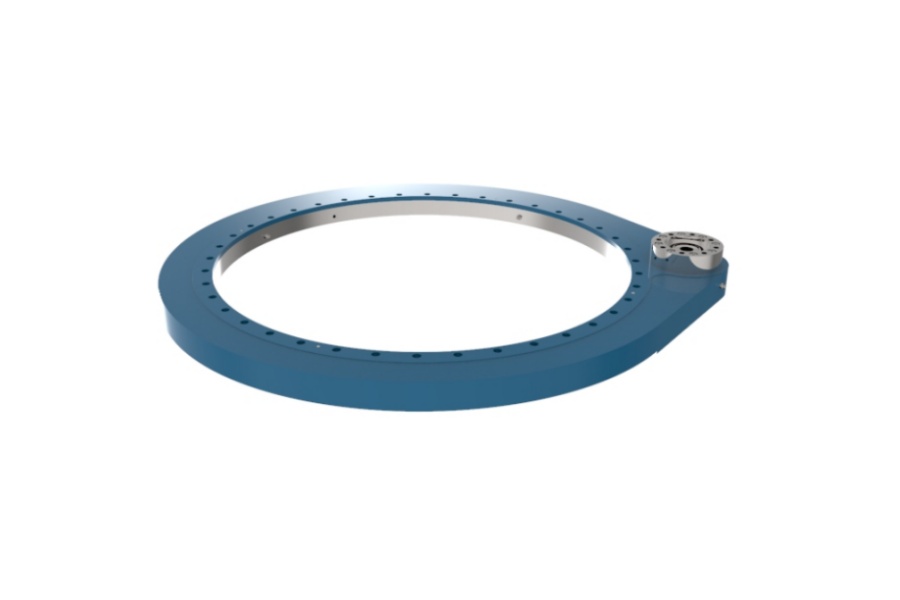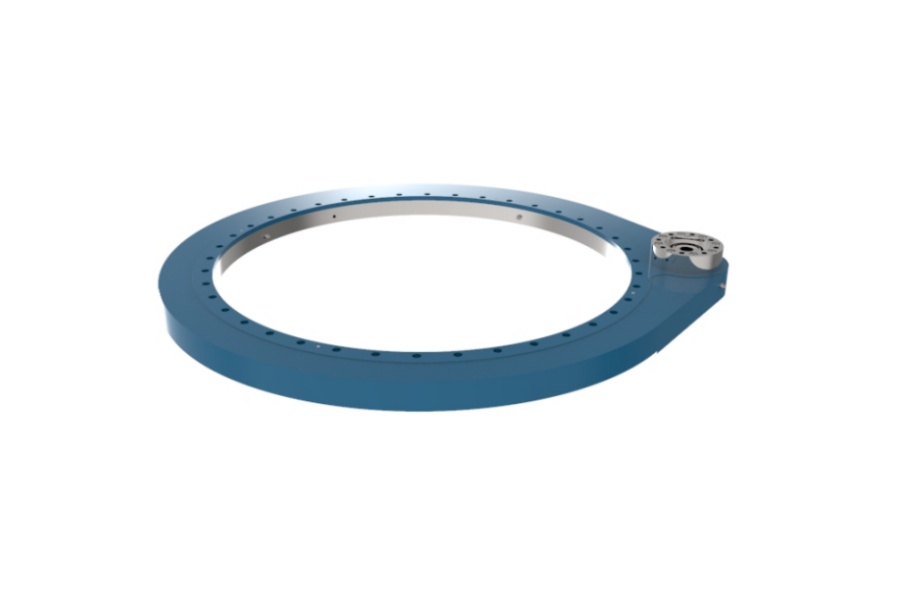
Analysis of HighSpeed Spur Gear Slew Drive Heat Dissipation Methods
What is Spur Gear Slew Drive
Spur Gear Slew Drive represents a specific and highly efficient category of slewing drives characterized by its use of a spur gear configuration. At its core, the system consists of a slewing ring bearing, which has a spur gear either machined directly into its outer or inner race. This gear meshes with a smaller input spur pinion gear, which is typically driven by an electric, hydraulic, or pneumatic motor. When the motor activates the pinion, it drives the large gear on the bearing race, causing the entire attached structure to rotate relative to the base. The simplicity of the spur gear teeth—straight and parallel to the axis of rotation—makes this design exceptionally efficient for transmitting power with minimal energy loss. However, this same efficiency, especially under high-speed and high-load conditions, generates significant internal heat from friction between the meshing gear teeth and within the bearing raceways. If this heat is not managed effectively, it can lead to premature lubricant degradation, loss of material hardness, thermal expansion that disrupts precise gear meshing, and ultimately catastrophic bearing or gear failure. Therefore, understanding and implementing robust heat dissipation strategies is not merely an enhancement but a critical requirement for the reliable operation of high-speed spur gear slew drives.

Analysis of Heat Dissipation Methods for HighSpeed Spur Gear Slew Drives
The operational limits of a high-speed spur gear slew drive are often dictated by its thermal management capabilities rather than its purely mechanical strength. Effective heat dissipation is paramount to prevent the detrimental effects of overheating. Advanced thermal management strategies focus on actively removing heat from the primary generation sources: the gear mesh interface and the slewing bearing's rolling elements.
A cornerstone of modern heat dissipation design involves a sophisticated forced lubrication system. This is far more than simple occasional greasing; it is a continuous, pressurized circulatory system. The slewing bearing's non-rotating structural components are often engineered in upper and lower sections. Machined directly into the base of the bearing's raceway is a dedicated oil channel or groove. The upper section features multiple symmetrically positioned oil inlet ports. High thermal-conductivity lubricating oil is pumped under pressure through these inlet ports, filling the raceway groove and thoroughly coating the rolling elements (balls or rollers). This pressurized flow does more than just lubricate; it forcibly carries away a massive amount of heat generated by friction. The lower section of the raceway is designed with an enlarged outlet channel, allowing the heated oil to drain rapidly and efficiently from the bearing core, preventing it from stagnating and overheating.
Containing this active oil system is critical. The interface between the slewing ring and the surrounding drive housing is sealed using advanced sealing strips, gaskets, or even protective baffles. These seals serve a dual purpose: they prevent the pressurized oil from leaking and splashing out, and they equally importantly keep external contaminants like abrasive dust and moisture from entering the system, which would degrade the oil's performance and damage components.
Simultaneously, the gear mesh itself requires direct and targeted cooling. The immense pressure and sliding action between the pinion teeth and the main gear teeth are a significant heat source. A dedicated oil injection jet or port is positioned directly opposite the point of mesh. This jet continuously sprays a stream of pressurized, high thermal-conductivity oil onto the engaging teeth. This direct impingement provides excellent lubrication under extreme pressure and offers instantaneous cooling, washing away metallic particles and transferring heat away from this critical focal point.
To complete the cooling cycle, the drive housing is equipped with strategically placed oil return outlets. These ports allow the hot oil, now drained from both the bearing raceway and the gear mesh area, to exit the housing quickly. This hot oil is then routed through an external heat exchanger or cooling radiator, where it is cooled before being recirculated back into the system by pumps, creating a continuous closed-loop cooling process.
Material selection also plays a vital role in thermal management. The high-speed pinion gear, which experiences the most rapid wear and heat generation due to its smaller size and faster rotation, is commonly manufactured from case-hardened carburizing steel. This material undergoes a heat treatment process that creates an extremely hard, wear-resistant outer surface while maintaining a tougher, more ductile core. This hardness reduces friction and wear at the tooth surface, inherently generating less heat, while the tough core provides the strength to withstand high cyclic loads without fracturing.
Finally, integrating smart monitoring systems elevates thermal management from a passive design feature to an active control parameter. Temperature sensors embedded within the housing adjacent to the bearing raceway and near the gear mesh provide real-time thermal data. This data can be fed back to a central control unit, which can modulate the speed of the oil pump, activate auxiliary coolers, or even reduce the drive's operational speed if temperatures approach a critical threshold, enabling predictive maintenance and preventing thermal overload.
Spur Gear Slew Drive Characteristics
The defining characteristics of the spur gear slew drive stem from its straightforward gear design. Its most significant advantage is high mechanical efficiency. The straight teeth of the spur gear mesh with minimal sliding contact compared to helical or worm gears, resulting in lower frictional losses and more direct power transmission. This translates to less energy consumption for the same output torque. Furthermore, the design is inherently simple, leading to easier manufacturing, more straightforward maintenance, and generally a more cost-effective solution compared to more complex drive types. The design also allows for a compact and rigid structure, providing high torque output and exceptional moment load capacity within a relatively small envelope. However, a notable characteristic is that spur gears can be louder than other gear types, especially at very high speeds, due to the single impact of teeth engaging and disengaging. Their performance is also highly dependent on precise alignment to ensure even load distribution across the tooth face.
Spur Gear Slew Drive Applications
The robust and efficient nature of spur gear slew drives makes them suitable for a wide array of applications across diverse industries. In solar power generation, they are the preferred mechanism for accurately positioning and tracking the movement of photovoltaic panels and concentrated solar power (CSP) heliostats throughout the day, requiring reliable and precise movement under significant wind loads. In the construction sector, they provide the rotational force for crawler cranes, enabling smooth and controlled slewing of the superstructure. The material handling industry utilizes them in the robust slew rings of stacker reclaimers and ship-to-shore container cranes at ports. They are also found within heavy-duty industrial rotators, welding positioners, and military equipment like radar antenna platforms and tank turret drives. Any application demanding reliable, high-torque, controlled rotation in a compact package is a potential use case for a spur gear slew drive.
Factors Affecting Spur Gear Slew Drive Price
The cost of a spur gear slew drive is not a fixed value but is influenced by a multitude of engineering and market factors. Primarily, the physical dimensions and load capacity are major determinants; a larger drive with higher torque and moment ratings requires more material, larger bearings, and more robust gears, significantly increasing cost. The choice of materials and the accompanying heat treatment processes, such as carburizing and hardening for gears, add to the expense but are essential for performance and durability. The complexity of the internal design, particularly the integration of advanced features like the sophisticated forced-oil cooling and circulation system described above, will raise the price compared to a simpler, grease-lubricated unit. Precision requirements, including gear quality (e.g., AGMA class), bearing precision, and overall manufacturing tolerances, dramatically affect cost, as higher precision demands more advanced machining and quality control. Additional components such as the type and quality of the integral motor, brake, or reduction gearbox also contribute to the final price. Finally, protection features like the grade of sealing (IP rating) for environmental protection and any special coatings for corrosion resistance (e.g., for marine environments) are also factored into the overall cost.
Supplier of spur gear slew drives
LYRADRIVE has established itself as a prominent manufacturer and supplier specializing in high-performance slewing drive solutions, including advanced spur gear slew drives. The company distinguishes itself through a strong focus on engineering excellence, rigorous quality control, and a customer-centric approach that offers both standard and highly customized drive configurations. LYRADRIVE's products are designed to meet the demanding requirements of various global industries, ensuring reliability, durability, and optimal performance in critical applications. By leveraging modern manufacturing technologies and a deep understanding of thermal management and mechanical design, LYRADRIVE provides robust solutions that effectively manage the challenges of heat dissipation in high-speed operations. Their commitment to technical support and providing cost-effective, value-driven products makes them a trusted partner for businesses seeking dependable rotational actuation systems.



